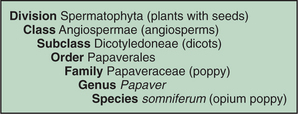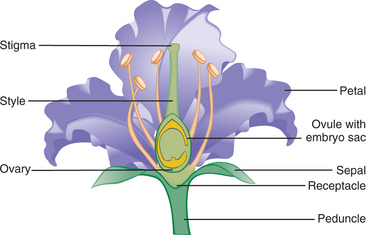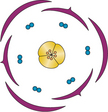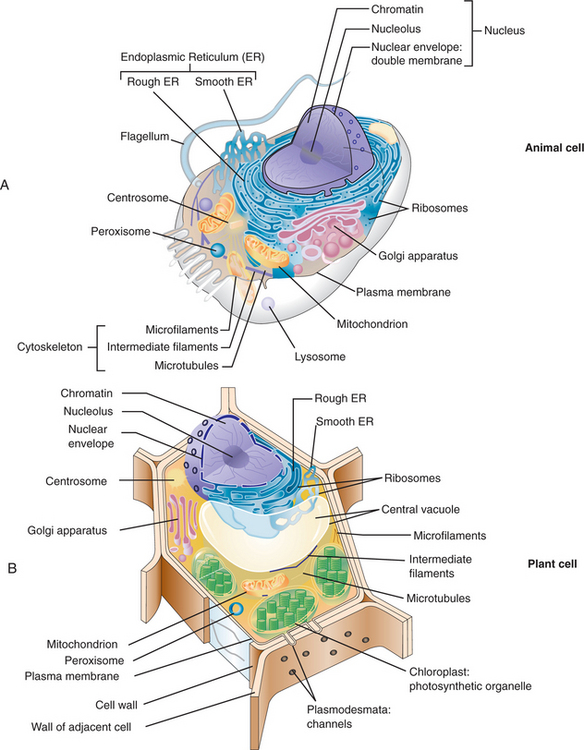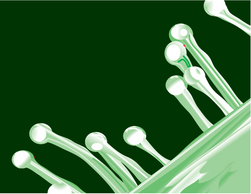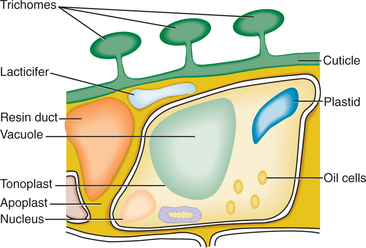CHAPTER 10 Medical Botany
WHAT IS MEDICAL BOTANY?
Today, medical botany is often simplified to the study of materia medica, natural substances that possess medicinal properties, as reflected in the newly revised edition of Medical Botany by Lewis and Elvin-Lewis (2003). This medically erudite treatment concentrates on the systems of the body and the herbs that affect these systems. Owing to a reliance on both conventional medicine and reductionistic ethnobotanical and natural products research, misinterpretations are common. Worse, a peculiar blindness to traditional medicine is sorely evident.
These two models of knowledge—traditional (indigenous) wisdom and conventional science—often do not agree. Conventional medicine, considered “evidence based,” uses concentrated chemicals with the therapeutic strategy of suppressing symptoms by inhibiting enzymes involved in normal metabolic and pathologic processes. However, the therapeutic strategy of traditional herbal medicine is to strengthen and resolve the underlying causes of pathology through gentle modulation of normal and pathologic processes. Additionally, traditional herbal products embrace complex forms of whole plant products, sometimes concentrated, but not to the degree found in conventional pharmacology (Table 10-1).
TABLE 10-1 Examples of Conventional Drugs Derived From Plants
| Drug | Activity | Plant Source |
|---|---|---|
| Digoxin | Cardiovascular | Digitalis purpurea L., Scrophulariaceae |
| Reserpine | Cardiovascular | Rauvolfia verticiliata (Loureiro) Baillon, Apocynaceae |
| Scutellarin | Cardiovascular | Scutellaria baicalensis Georgi, Lamiaceae |
| Synephrine | Cardiovascular | Citrus aurantium L., Rutaceae |
| Camptothecine | Anticancer | Camptotheca acuminata Decne, Nyssaceae |
| Taxol | Anticancer | Taxus chienensis (Pilg.) Rehder, Taxaceae |
| Vinblastine | Anticancer | Catharanthus roseus (L.) G. Don, Apocynaceae |
| Huperzine A | Nervous system | Huperzia serrata (Thunb.) Rothm., Lycopodiaceae |
| Levodopa | Nervous system | Mucuna cochinensis (Lour.) A. Chev., Fabaceae |
| Scopolamine | Nervous system | Scopolia japonica Maxim., Solanaceae |
| Codeine | Respiratory system | Papaver somniferum L., Papaveraceae |
| Allicin | Antimicrobial | Allium sativum L., Liliaceae |
| Berberine | Antimicrobial | Berberis julianae C.K. Schneid., Berberidaceae |
| Silymarin | Digestive system | Silybum marianum (L.) Gaertn., Asteraceae |
| Arteannuin | Parasiticide | Artemisia annua L., Asteraceae |
“the inability to see or notice the plants in one’s own environment—leading to (a) the inability to recognize the importance of plants in the biosphere, and in human affairs; (b) the inability to appreciate the aesthetic and unique biological features of the life forms belonging to the Plant Kingdom; and (c) the misguided, anthropocentric ranking of plants as inferior to animals, leading to the erroneous conclusion that they are unworthy of human consideration” (Wandersee & Schussler, 1998).
Veterinarians are in a unique position to observe fascinating similarities among three major groups of organisms if they add medical botany to their expertise. Herbal medicine requires an understanding of both traditional therapeutic models and the botany and chemistry of medicinal plants—the tools employed by these models. Medical botany encompasses this latter study, although it must compete with many other disciplines important to herbal medicine practitioners. Medical botany is deeply woven throughout ethnobotany, economic botany, entomology (study of insects), plant pathology, horticulture, microbiology, mycology (fungi), molecular cell biology, and toxicology. Most practitioners can barely keep up with their own specialty! Therefore, this chapter attempts to provide a basic overview for the veterinary herbalist, while revealing the extraordinary depth of plants and explaining their role in the health of all living creatures on our planet.
TAXONOMY
Plants are multicelled organisms placed in the Eukaryote domain, which includes Protista, Fungi, and Animalia. Plants are first divided into nonvascular and vascular groups. Nonvascular plants fall into two major categories: green algae, including diatoms and slime molds; and bryophytes, including liverworts, hornworts, and mosses. These are nonvascular because they lack xylem and phloem—water- and food-conducting tissues present in vascular plants. Vascular plants are divided into pteridophytes (horsetails and club mosses), gymnosperms (pines, junipers, Ephedra), and angiosperms (monocots and dicots). Most medicinal plants are found among the 250,000 angiosperm species, supporting the theory that plants have been developing more complex chemistry, along with their more intricate morphology (Gottlieb, 2002).
Taxonomy allows authorities to group plants according to any rule they choose. Thus, many classifications have been suggested for flowering plants. Taxonomists, systematicists, and botanists write floras based on the interpretation of their favored taxonomic authority. This is why no one can say for sure just how many plant families exist. Some authorities maintain that there are 350 plant families; others (fondly referred to as “splitters”) have divided plant genera into 520 families (Cullen, 1997). The important thing for herbalists to remember is that they must not mix up authorities. One should stick to one authority, usually the author of the flora (list of plants) of your region.
The International Code of Botanical Nomenclature has set some basic rules. A plant name (or binomial) has two parts: a genus that is grouped into a family and a species that is grouped under that genus. For example, peppermint (Mentha piperita), spearmint (M. spicata), and field mint (M. arvensis) are grouped under the genus Mentha. Genera (plural) are placed in families, which are placed in orders, which are placed in subclasses, classes, and, finally, a division. This system gives a specific plant species the same Latin name for use all over the world. New name changes turn old names into synonyms. Latin names are always italicized as indicated. Figure 10-1 gives an example of the nomenclature scheme.
Each Latin bionomial is followed by a shortened acronym for the author who named that particular species. For example, Cannabis sativa L. was first named by Linnaeus. When a species name is changed, the original author is placed in parentheses, with the new author following, such as Cimicifuga racemosa (L.) Nutt. This is black cohosh, a species formerly named Actaea racemosa L. Recently, Cimicifuga racemosa (L.) Nutt. was returned to the genus Actaea L. (Compton, 1998)! It will take decades for this new name to become accepted in the literature. Herbalists may want to use this new name but many botanists will continue to employ Cimicifuga. It does not matter which name is used, as long as we all understand which plant species is being referred to. History suggests that herbalists have to be bilingual. Black cohosh can be found in old Eclectic texts as Macrotys. Burdock (Arctium lappa) was once named Lappa major, and Echinacea was once Brauneria.
Many changes have recently been made to the names of plants because it was discovered that some plants are not related after all. This is because plants were originally classified by morphology. We now know that many plants with similar anatomic structure are actually not closely related. Similar-looking species sometimes achieve their design through convergent, or parallel, evolution. For example, both seals and penguins possess flippers. However, seals are mammals and penguins are birds. Both organisms developed flippers through independent means, not through common ancestral traits. Chloroplast and mitochondrial DNA provide stronger evidence than physical alikeness, which can be more subjective. Thus, many plant species have been moved to other families, causing some confusion and frustration among botanists and herbalists alike.
PLANT IDENTIFICATION
Wild plants are identified with a plant key or flora for the local area in which the plant is found, although floras are not available for all states. Some floras, such as Manual of Vascular Plants, by Gleason, or Vascular Plants of the Pacific Northwest, by Hitchcock and Cronquist, encompass many states. Floras give lengthy, erudite descriptions of plant species employing scholarly terminology. To identify the flora or plant key for a particular country or state, one should make inquiries to a university herbarium or native plant society in the community. An illustrated glossary is essential, such as Plant Identification Terminology, by Harris and Harris. A plant cannot be keyed out unless it is in the flowering stage because most floras are based on the parts of a flower (Figure 10-2). The main parts of a flower consist of (from outside to inside) sepals, petals, stamens, and pistil. Floral diagrams (Figure 10-3) are commonly used to show the morphology and number of flower parts.
The diagram in Figure 10-3 illustrates a flower with three sepals in the outer whorl, three petals in the next inner whorl, six stamens (with paired anthers), and a three-parted pistil. This particular diagram thus shows a monocot species, possessing flower parts in 3’s and 6’s.
Floral formulas are commonly used. However, one must first become familiar with the meaning of the symbols in the formula. The four floral series—calyx, corolla, androecium, and gynoecium (see Glossary on p. 156)—are represented as follows:
As an example, the floral formula, K5 Cz 1+(2) + 2 A 9 + 1 G 1, denotes the following:
PLANT ANATOMY
In a basic biology class, one learns that animal and plant cells share a common basic structure (Figure 10-4). All cells are bounded by a plasma membrane with cytoplasm inside, along with membrane-bound organelles such as a nucleus, mitochondria, peroxisomes, ribosomes, endoplasmic reticulum, and golgi complex. These organelles perform many of the same functions, whether in animal or plant cells. For example, the principal function of mitochondria is to generate energy in the form of adenine triphosphate (ATP). The main differences, seen in Box 10-1, are that animal cells contain lysosomes, centrioles, and sometimes flagella (organelles that provide locomotion for the cell, such as in sperm cells). Plant cells, on the other hand, are unique in that they possess a cell wall, plastids, a vacuole, and plasmodesmata.
BOX 10-1 The Major Differences Between Animal and Plant Cells
| ANIMAL CELLS | PLANT CELLS |
|---|---|
| Lysosomes | Cell wall |
| Centrioles | Plastids |
| Flagella | Vacuole and tonoplast |
| Plasmodesmata |
Signal transduction and secondary messaging also occur in plant cells. External and internal stimuli activate receptor proteins and provide signals that trigger complex signal transduction processes. Many plant signaling pathways are very similar to those found in animals. GTPases, phospholipids, calcium signaling networks, and protein kinases are important components of plant signaling processes that are also found in animal systems. Despite the major differences between plant and animal cells, the laws of energy and the processes of glycolysis and the citric acid cycle are similar in plants. Although plants can synthesize unique substances, plants contain many of the same enzymes that are found in animals. This is one reason why plants can be used to produce vaccines and human proteins such as antibodies.
Similar to animals, plants synthesize hormones that have roles in growth and development, as well as in defense and immunity. Plant scientists do not know as much about plant hormones as medical scientists know about human hormones. This is unfortunately due to both emphasis in the science and funding. It is interesting to note that some plants manufacture hormones that are also found in animals, such as serotonin, melatonin, and acetylcholine. The section on similarities in communication, defense, and detoxification elaborates on this subject.
Some plant compounds do not become active until they are broken down by enzymes stored in a different area within the plant. Some defense compounds are safely stored next to a vesicle that contains the enzymes needed to transmute them to the defense form. Crushing these tissues, whether by an herbivore or by collection, drying, or processing procedures, often combines the necessary ingredients. In garlic, allinase combined with alliin forms allicin, a potent antimicrobial. Young leaves of Catharanthus roseus (Madagascar periwinkle) accumulate glucoalkaloid strictosidine in the vacuole. Surrounding this vacuole are high levels of an enzyme that, when mixed with strictosidine, turns into a strong, protective antimicrobial compound (Verpoorte, 1998).
Plant compounds are made in specific parts of the cell and are transported and stored in specific areas of the plant cell based on their polarity (Figures 10-5 and 10-6; Box 10-2). The choice of where these compounds are stored depends greatly on the hydrophobicity and hydrophilicity of the compound. For example, hydrophilic compounds such as flavonoids and tannins tend to be stored in the vacuoles, laticifers, and apoplasts of plant tissues. Lipophilic compounds such as terpenes, waxes, and anthraquinones tend to be stored in resin ducts, oil cells, and trichomes (Figure 10-6). It may be surprising to the reader that plant scientists understand little of how plant compounds are transported to storage compartments such as trichomes, far from their source of manufacture. In fact, scientists only recently discovered what triggers flowering! Plant chemistry and natural product research trudges rather slowly behind human and mammalian biochemistry and physiology.
BOX 10-2 Hydrophilic and Hydrophobic Plant Compounds and Their Storage Compartments
| HYDROPHILIC COMPOUNDS | HYDROPHOBIC COMPOUNDS |
|---|---|
| Vacuole | Cuticle < div class='tao-gold-member'> Only gold members can continue reading. Log In or Register to continue
Stay updated, free articles. Join our Telegram channel
Full access? Get Clinical Tree
 Get Clinical Tree app for offline access
Get Clinical Tree app for offline access

|
